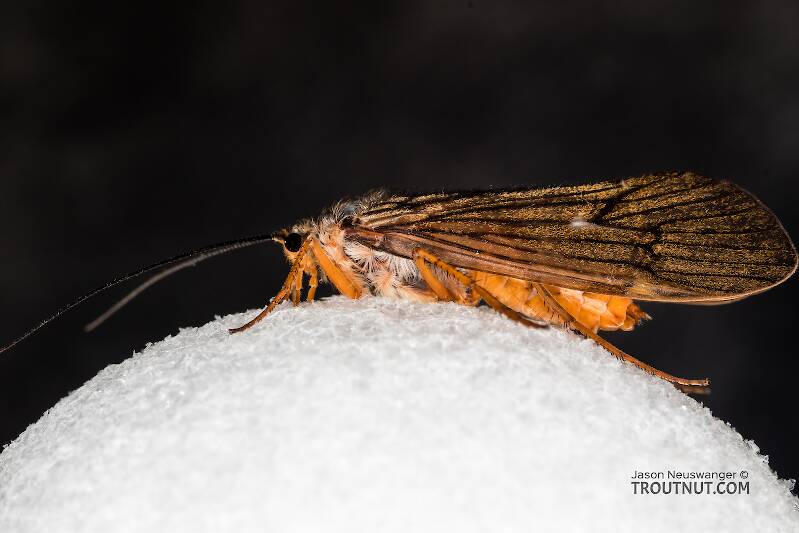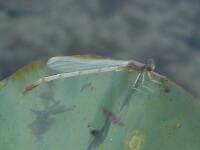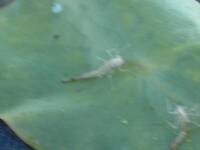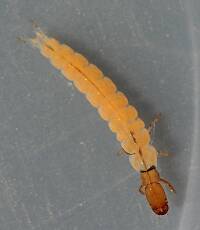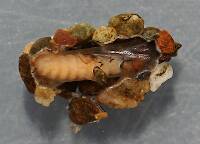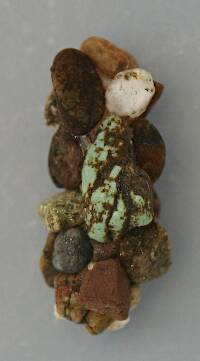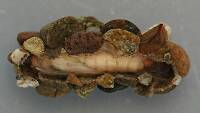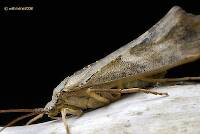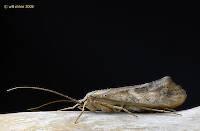
Hex Mayflies
Hexagenia limbata
The famous nocturnal Hex hatch of the Midwest (and a few other lucky locations) stirs to the surface mythically large brown trout that only touch streamers for the rest of the year.
Featured on the forum

This specimen resembled several others of around the same size and perhaps the same species, which were pretty common in my February sample from the upper Yakima. Unfortunately, I misplaced the specimen before I could get it under a microscope for a definitive ID.

Troutnut is a project started in 2003 by salmonid ecologist Jason "Troutnut" Neuswanger to help anglers and
fly tyers unabashedly embrace the entomological side of the sport. Learn more about Troutnut or
support the project for an enhanced experience here.
This topic is about the Insect Order Trichoptera
Some say caddisflies are even more important than mayflies, and they are probably right. The angling world has taken a while to come to terms with this blasphemy. Caddis imitations are close to receiving their fare share of time on the end of the tippet, but too many anglers still assume all caddisflies are pretty much the same.Caddis species actually provide as much incentive to learn their specifics as the mayflies do. There is just as much variety in their emergence and egg-laying behaviors, and as many patterns and techniques are needed to match them. Anglers are hampered only by the relative lack of information about caddisfly behavior and identification.
Example specimens
Fishhead990 on Oct 25, 2010October 25th, 2010, 12:08 pm EDT
I have been searching photos here trying to identify a particular caddis and can't find what I'm looking for. Unfortunately I don't have a photo so I'll try a description.
First of all the caddis in question is located in small, heavily vegetated lakes in the foothills east of Yellowstone Park. The adults are up 1 1/4 inch in length from head to rear wing tip. The abdomen and thorax are light olive in color, the legs are tan with just a hint of light olive. The wings are very light tan/off-white in color. the antennea are very short for a caddis at 3/8-1/2 inch in length and medium tan in color.
Locally they are referred to as "Big Horned Caddis". They emerge in late spring/early summer for about 4 weeks starting at the time the submerged vegetation beds become well established. The pupa opens and the adult appears almost immediately upon reaching the surface making collection of the pupa almost impossible from the surface as they emerge from deep water.
On emergence the adult takes flight and disappears later returning to "skate" across the lake surface I suspect depositing eggs as I have yet to observe one diving although this may be due to the fact that trout are savagely feeding on these skating adults and my emtemolocical focus is greatly disturbed.
Any help identifying these caddis will be greatly appreciated. Thanks in advance for your help.
John
First of all the caddis in question is located in small, heavily vegetated lakes in the foothills east of Yellowstone Park. The adults are up 1 1/4 inch in length from head to rear wing tip. The abdomen and thorax are light olive in color, the legs are tan with just a hint of light olive. The wings are very light tan/off-white in color. the antennea are very short for a caddis at 3/8-1/2 inch in length and medium tan in color.
Locally they are referred to as "Big Horned Caddis". They emerge in late spring/early summer for about 4 weeks starting at the time the submerged vegetation beds become well established. The pupa opens and the adult appears almost immediately upon reaching the surface making collection of the pupa almost impossible from the surface as they emerge from deep water.
On emergence the adult takes flight and disappears later returning to "skate" across the lake surface I suspect depositing eggs as I have yet to observe one diving although this may be due to the fact that trout are savagely feeding on these skating adults and my emtemolocical focus is greatly disturbed.
Any help identifying these caddis will be greatly appreciated. Thanks in advance for your help.
John
At work, at play, in life...I am a fisherman...just ask my wife!
Konchu on Oct 25, 2010October 25th, 2010, 1:38 pm EDT
Here's hoping user Creno chimes in soon...
Taxon on Oct 25, 2010October 25th, 2010, 2:50 pm EDT
PaulRoberts on Oct 25, 2010October 25th, 2010, 7:01 pm EDT
Dicosmoecus possibly -called the "October Caddis". Huge, long antennae, rusty colored with a pale stripe on the wing. We have them here in Colorado.
Fishhead990 on Oct 26, 2010October 26th, 2010, 10:07 am EDT
Paul,
I am almost certain it is not the Dicosmoecus, absolutely no hint of rust or orange color on the entire insect. The antennea are half the length of the body and very thick.
Taxon,
the Clistoronia appears to be of the proper configuration and from what I can tell from the photo the colors seem to be correct. Thanks for your help I'm off to do a bit more research. I'll let you all know what I come up with. I appreciate you giving me a place to start.
John
I am almost certain it is not the Dicosmoecus, absolutely no hint of rust or orange color on the entire insect. The antennea are half the length of the body and very thick.
Taxon,
the Clistoronia appears to be of the proper configuration and from what I can tell from the photo the colors seem to be correct. Thanks for your help I'm off to do a bit more research. I'll let you all know what I come up with. I appreciate you giving me a place to start.
John
At work, at play, in life...I am a fisherman...just ask my wife!
Taxon on Oct 26, 2010October 26th, 2010, 4:22 pm EDT
Just received a copy of the following from Dave Ruiter:
John -
sorry I cannot respond on Troutnut as my login is not working and
Jason is really busy right now so no time to fix the problem. No telling when I will get back on so here is my guess:
I suspect it is either a limnephilid or phryganeid, and, given the info you provided, I would go with the phryganeid. Tom Ames has a good discussion of the differences in emergence habits of both families in his recent caddisfly book. To summarize, most phryganeids emerge from the water surface, and limnephilids emerge on some type of structure.
Roger's color choice is good (although that specimen is quite faded from the live color) and there are alot of other limnephilids with that same color. [I don't think any Clistoronia occur in lakes big enough to maintain fish. They are usually in small, highly vegetated, shallow "ponds" often with some type of flowing water (stream, seepage flow, etc.) going through them.] In the Rockies phryganeids are quite common and highly fishable in ponds and lakes and several of the phryganeids are also quite pale. And all caddis immediately on emergence as you are seeing them, are very pale with poorly developed color patterns (teneral). Depending on the taxa and the weather it may take several hours before the final color patterns and darkening develop.
Hope that helps - I have had a long time interest in WY caddis so if you ever want to collect I will be more than happy to provide determinations - and the gear to collect if you are really interested.
Have a great day!
creno - on Troutnut
dave
UPDATE: Per email from Dave on 11/1/2010:
Apparently C. magnifica occurs in fishable lakes and are sought by rainbows as larva, particularly under the ice.
PaulRoberts on Oct 27, 2010October 27th, 2010, 11:20 am EDT

Here is a Phyrganeid from central NY (correct me if I mis-ID'd it, Dave or Roger). Sorry for the poor image -Most of my bug pictures are on 35mm transparencies, and I digitized it with a point-n-shoot.
This one doesn't fit your description as far as color goes, but it does have heavy antennae. They are big bugs too.
PaulRoberts on Oct 27, 2010October 27th, 2010, 1:43 pm EDT
Thanks Roger. I was at a University then and had access to a lot of materials, so I probably would have keyed it out.
Entoman on Jan 27, 2011January 27th, 2011, 6:59 pm EST
John -
It's interesting how local vernacular can confuse the issue sometimes. The only lake dwelling caddis I'm aware of going by the handle "Long Horn Sedge (Caddis)" are species of the genera Oecetis in the Family Leptoceridae. The "longhorn" comes from their antennae being much longer than their wing tip to head measurement. Besides being too large, your sample's antennae are way too short (as described). Their antennae length also rules out lake dwelling Limnephilids, in spite of their large size. This includes Dicosmoecus (October Caddis), which usually dwells in moving water (though I have found them pretty far out in some lakes-having migrated from an inlet in prep for pupation).
Based on the info you provided, I'm pretty confident (which means I'd bet a breakfast) they're Phryganeids... But if I had to hazard a guess as to genus, maybe Agrypnia (Great Dive-Bomber Sedge)? Both Ptilostomis (Great Rusty Sedge) and Phryganea (Rush Sedge) genera are noted for having brownish bodies. The Banksiola (Traveling Sedge) genus has the greenish bodies you describe but their emergence behavior is different as befits their name and their wings are usually dark and/or heavily patterned. All of them have shorter and relatively stout antennae, as you described. The problem is coloration and emergence behavior are not dogmatically exclusive enough among members of this group of large lake dwellers to be conclusive aides in determining genera and species. Even some of the Limnephlids have been reported to scoot around at times.
Regards,
Kurt
It's interesting how local vernacular can confuse the issue sometimes. The only lake dwelling caddis I'm aware of going by the handle "Long Horn Sedge (Caddis)" are species of the genera Oecetis in the Family Leptoceridae. The "longhorn" comes from their antennae being much longer than their wing tip to head measurement. Besides being too large, your sample's antennae are way too short (as described). Their antennae length also rules out lake dwelling Limnephilids, in spite of their large size. This includes Dicosmoecus (October Caddis), which usually dwells in moving water (though I have found them pretty far out in some lakes-having migrated from an inlet in prep for pupation).
Based on the info you provided, I'm pretty confident (which means I'd bet a breakfast) they're Phryganeids... But if I had to hazard a guess as to genus, maybe Agrypnia (Great Dive-Bomber Sedge)? Both Ptilostomis (Great Rusty Sedge) and Phryganea (Rush Sedge) genera are noted for having brownish bodies. The Banksiola (Traveling Sedge) genus has the greenish bodies you describe but their emergence behavior is different as befits their name and their wings are usually dark and/or heavily patterned. All of them have shorter and relatively stout antennae, as you described. The problem is coloration and emergence behavior are not dogmatically exclusive enough among members of this group of large lake dwellers to be conclusive aides in determining genera and species. Even some of the Limnephlids have been reported to scoot around at times.
Regards,
Kurt
"It's not that I find fishing so important, it's just that I find all other endeavors of Man equally unimportant... And not nearly as much fun!" Robert Traver, Anatomy of a Fisherman
Entoman on Jan 27, 2011January 27th, 2011, 7:46 pm EST
Roger -
BTW, could the tips of the Antennae in the picture you provided of Clistoronia been damaged? They look pretty short and blunt for a Limnephilid.
Kurt
BTW, could the tips of the Antennae in the picture you provided of Clistoronia been damaged? They look pretty short and blunt for a Limnephilid.
Kurt
"It's not that I find fishing so important, it's just that I find all other endeavors of Man equally unimportant... And not nearly as much fun!" Robert Traver, Anatomy of a Fisherman
Entoman on Jan 27, 2011January 27th, 2011, 7:52 pm EST
Roger -
BTW, I think the tips of the Antennae in the picture you provided of Clistoronia have been damaged. They look pretty short and blunt for a Limnephilid.
Kurt
BTW, I think the tips of the Antennae in the picture you provided of Clistoronia have been damaged. They look pretty short and blunt for a Limnephilid.
Kurt
"It's not that I find fishing so important, it's just that I find all other endeavors of Man equally unimportant... And not nearly as much fun!" Robert Traver, Anatomy of a Fisherman
Creno on Jan 29, 2011January 29th, 2011, 11:54 am EST
Entoman - did you find this definition:
'The "longhorn" comes from their antennae being much longer than their wing tip to head measurement.'
in the entomological literature? I have always wondered where. other than the angling literature, it may have come from.
thanks
Creno
'The "longhorn" comes from their antennae being much longer than their wing tip to head measurement.'
in the entomological literature? I have always wondered where. other than the angling literature, it may have come from.
thanks
Creno
Entoman on Jan 30, 2011January 30th, 2011, 11:20 am EST
Hi Creno,
Actually, that's not a quote (at least consciously). I based the statement on the assumption that "long horn" couldn't refer to anything else. I must have read that explanation somewhere as well, but can't remember where. Probably lots of places. It had to be angling literature though. As to it's roots, my bet is it goes back a long ways. Maybe back to the days of Dame Juliana Berners when they called them Caddice, Caperers and such? Maybe even in non-angling literature and poetry. I have no idea if the explanation for the name "Long Horn" is in any entomological work, but my uneducated guess is probably not? The ones I look at most often do mention that the Leptocerids have antennae much longer than most caddis or extremely long compared to other families (or similar language) but that's as close as they get. I have read in other works where the whole family is referred to as Longhorn Casemakers, but they leave to the reader what that means. In fact, they never seem to mention common names for species, let alone a direct translation of the Latin. At least not that I've seen. Not that an english translation would help much because I believe a lot of the names go back pretty far and are not necessarily tied to descriptive parts of their anatomy anyway; let alone those parts that would later prove the most significant in separating them from other families and genera.
It would be fascinating if an Etymologist and an expert in the history of Entomology or Taxonomy could get together and publish a work on the why's and when's of aquatic insect naming, translations and root words, etc. We need to find them and plant the fly fishing germ! :)
Best regards,
Kurt
Actually, that's not a quote (at least consciously). I based the statement on the assumption that "long horn" couldn't refer to anything else. I must have read that explanation somewhere as well, but can't remember where. Probably lots of places. It had to be angling literature though. As to it's roots, my bet is it goes back a long ways. Maybe back to the days of Dame Juliana Berners when they called them Caddice, Caperers and such? Maybe even in non-angling literature and poetry. I have no idea if the explanation for the name "Long Horn" is in any entomological work, but my uneducated guess is probably not? The ones I look at most often do mention that the Leptocerids have antennae much longer than most caddis or extremely long compared to other families (or similar language) but that's as close as they get. I have read in other works where the whole family is referred to as Longhorn Casemakers, but they leave to the reader what that means. In fact, they never seem to mention common names for species, let alone a direct translation of the Latin. At least not that I've seen. Not that an english translation would help much because I believe a lot of the names go back pretty far and are not necessarily tied to descriptive parts of their anatomy anyway; let alone those parts that would later prove the most significant in separating them from other families and genera.
It would be fascinating if an Etymologist and an expert in the history of Entomology or Taxonomy could get together and publish a work on the why's and when's of aquatic insect naming, translations and root words, etc. We need to find them and plant the fly fishing germ! :)
Best regards,
Kurt
"It's not that I find fishing so important, it's just that I find all other endeavors of Man equally unimportant... And not nearly as much fun!" Robert Traver, Anatomy of a Fisherman
Creno on Jan 31, 2011January 31st, 2011, 7:08 am EST
Entoman - The quotes I placed on the language from your previous post. I guess I should have looked a little harder rather than just ask.
According to Jaeger 1944 (Jaeger,E.C. 1944, A source-book of biological names and terms. Thomas Publishing, Springfield, Ill., 256p) keras is Greek for horn and leptos is Greek for slender, thin, small, week. So - slender horn. However, Wiggins 2004 (Wiggins, G.B. 2004. Caddisflies: the underwater architects. Toronto, University of Toronto Press, 292p) indicated keras is Greek for antennae - resulting in slender antenna.
I guess I still don't know. While leptocerid antenna are indeed long and slender there are non-leptocerids with long slender antennae, e.g. Macrostemum. I guess I took the term horn to be actually horn-like and perhaps referred to the palps which often extend to the front like a horn when the leptocerid adult is at rest.
Oh well - just curious.
creno
According to Jaeger 1944 (Jaeger,E.C. 1944, A source-book of biological names and terms. Thomas Publishing, Springfield, Ill., 256p) keras is Greek for horn and leptos is Greek for slender, thin, small, week. So - slender horn. However, Wiggins 2004 (Wiggins, G.B. 2004. Caddisflies: the underwater architects. Toronto, University of Toronto Press, 292p) indicated keras is Greek for antennae - resulting in slender antenna.
I guess I still don't know. While leptocerid antenna are indeed long and slender there are non-leptocerids with long slender antennae, e.g. Macrostemum. I guess I took the term horn to be actually horn-like and perhaps referred to the palps which often extend to the front like a horn when the leptocerid adult is at rest.
Oh well - just curious.
creno
Entoman on Jan 31, 2011January 31st, 2011, 9:25 am EST
Hi Creno,
Thanks for the heads up on the books! Fun stuff. Macrostemum... Hmm... Just a guess, but could that mean large or long stemmed? Another word for antennae? Of course there's Macronema, and there's certainly nothing big on them. Interesting comment about the palps. Maybe... I dunno. Too many caddis running around with the name "Short Horned" and little antennae for that to work I think. Of course, fishermen, poets, and scientists would never mix metaphores amongst each other, right?... Heck, If I got to name Mystacides, I would have called them "Little Black Club Faces"! Latinized of course.:)
Regards,
Kurt
Thanks for the heads up on the books! Fun stuff. Macrostemum... Hmm... Just a guess, but could that mean large or long stemmed? Another word for antennae? Of course there's Macronema, and there's certainly nothing big on them. Interesting comment about the palps. Maybe... I dunno. Too many caddis running around with the name "Short Horned" and little antennae for that to work I think. Of course, fishermen, poets, and scientists would never mix metaphores amongst each other, right?... Heck, If I got to name Mystacides, I would have called them "Little Black Club Faces"! Latinized of course.:)
Regards,
Kurt
"It's not that I find fishing so important, it's just that I find all other endeavors of Man equally unimportant... And not nearly as much fun!" Robert Traver, Anatomy of a Fisherman
Quick Reply
Related Discussions
Topic
Replies
Last Reply
1
Jul 11, 2008
by Taxon
by Taxon
8
Aug 25, 2014
by Millcreek
by Millcreek
3
Jul 24, 2007
by Wiflyfisher
by Wiflyfisher
Re: Identification of a possible Cordulegaster Dragonfly Nymph
In Cordulegaster Dragonfly Nymph by IanB
In Cordulegaster Dragonfly Nymph by IanB
6
Feb 10, 2017
by Taxon
by Taxon


